Experimental investigation on uniaxial cyclic plasticity of cast AZ91 magnesium alloy
2023-12-27YuLeiZiyiWangGuozhengKang
Yu Lei,Ziyi Wang,Guozheng Kang
Applied Mechanics and Structure Safety Key Laboratory of Sichuan Province, School of Mechanics and Aerospace Engineering, Southwest Jiaotong University, Chengdu 610031, China
Abstract The uniaxial cyclic plasticity of cast AZ91 magnesium (Mg) alloy was investigated by conducting a series of cyclic straining and stressing tests at room temperature,and a unique cyclic plasticity (especially for ratchetting) and its physical nature were revealed.The experimental results demonstrate that the cast AZ91 Mg alloy behaviors tension-compression symmetry,because the dislocation slipping and twinning occur during both the tensile and compressive deformations;although the cast AZ91 alloy presents a certain pseudo-elastic behavior during unloading due to the detwinning,there is no obvious S-shaped asymmetric hysteresis loop like that of wrought Mg alloy in the cyclic tensile-compressive tests,and an obvious cyclic hardening is observed;moreover,the ratchetting of the cast AZ91 alloy presented in the cyclic stressing tests depends remarkably on the prescribed mean stress and stress amplitude,but slightly changes with the stress rate,and the evolution of responding peak/valley strain greatly differs from that of wrought Mg alloys and stainless steels.This work provides rich experimental data for establishing the constitutive model of cast Mg alloys.
Keywords: Cast magnesium alloy;Ratchetting;Twinning/detwinning;Stress level;Stress rate.
1.Introduction
Magnesium (Mg) alloys,as the lightest kind of metallic structural materials,have been utilized in various manufacturing industries [1–4].In practical applications,Mg alloys are inevitably subjected to a cyclic loading,resulting in the fatigue failure [5].Due to the unique HCP crystal structure,the major mechanisms of plastic deformation operating in Mg alloys are both the dislocation slipping and twinning;accordingly,a complicated cyclic plastic deformation (including the ratchetting,that is,a cyclic accumulation of plastic deformation) occurs in the cyclic straining and stressing tests.Thus,the experimental observation on the uniaxial cyclic plasticity of Mg alloys is vitally important for constructing corresponding constitutive model and predicting the fatigue life.
Commonly used Mg alloys mainly include the cast and wrought Mg alloys.In general,the wrought Mg alloys exhibit higher yield strength and better ductility than that of cast Mg alloys [6].The improved strength of wrought Mg alloys results from the grain refinement and the formation of strong basal plane texture,which makes the non-basal prismatic dislocation slipping in the prismatic and pyramidal slip planes activated [7].However,compared with the wrought Mg alloys,the cast Mg alloys have shorter processing period and lower assembly cost in the batch production of components[4],which also makes the casting become as a dominant manufacturing process of Mg alloy components [8].Unlike the wrought Mg alloys,the cast Mg alloys exhibit random grain orientations without any strong basal texture [9],and often show a tension-compression symmetry [10],except for the tension-compression asymmetry shown in [11–13].Nevertheless,the cast Mg alloys shall present a cyclic plasticity different from that of the face-centered cubic (FCC) [14,15]and body-centered cubic (BCC) [16]metals,considering the participation of twinning/detwinning in the process of plastic deformation.
In the uniaxial cyclic straining tests,Patel et al.[17]found that different from the FCC and BCC metals,the cast Mg alloys presented a pseudo-elastic behavior during the unloading due to the occurrence of detwinning.Also,different from the significantly asymmetrical stress-strain hysteresis loops of wrought Mg alloys [5,18,19],symmetrical hysteresis loops are observed in the cyclic straining tests of cast Mg alloys at moderate strain amplitudes [20,21].As observed by Karparvarfard et al.[21]for the cast ZK60 Mg alloy,the hysteresis loops with slight asymmetric shapes will appear in the cyclic tests with high strain amplitudes;but,the number of twins formed in the cast Mg alloy is much smaller than that of wrought Mg alloy in the cyclic tests with the same applied strain amplitude.
Previous studies [14,16,22]have illustrated that in the cyclic stressing tests of metallic materials with a non-zero mean stress and a high enough stress level (higher than the material yielding stress),ratchetting will occur.At present,some experiments have been conducted by some researchers to examine the ratchetting of wrought Mg alloys [23–29],which is much more complicated than that of the metals with cubic crystal structures,due to an interaction of different plastic deformation mechanisms in Mg alloys.For instances,Kang et al.[23]revealed systematically the uniaxial ratchetting of extruded AZ31 Mg alloy with different deformation mechanisms involved by performing the cyclic stressing tests under various stress levels;Further,Lei et al.[24]conducted an experimental research on the ratchetting-fatigue interaction of extruded AZ31 Mg alloy,and then Wang et al.[25]investigated its damage mechanism by in-situ synchrotron X-ray tomography investigation;Moreover,Xiong et al.[29]discussed the influence of twinning/detwinning mechanism on the ratchetting of wrought ZK60 Mg alloy in detail.However,to date,only a few studies were related to the plastic deformation of cast Mg alloys in the cyclic stressing tests [30–33].For examples,Cáceres et al.[30]observed the pseudo-elastic behavior of cast AZ91 Mg alloy in the cyclic loading-unloading process,and then explained the physical nature of such a phenomenon by addressing the contribution of twins;Chen et al.[32]and Luo et al.[33]provided some basic results for the ratchetting of cast AZ91D Mg alloys,but did not pay more attention on the effect of different plastic deformation mechanisms on the ratchetting.In addition,Čapek et al.[34]examined the capability of crystal plasticity based constitutive model to predict the monotonic plastic deformation of cast Mg alloys.In summary,it is deserved to launch a series of experimental investigations on the cyclic plasticity of cast Mg alloys and enrich the experimental data for the construction of constitutive model.
So,in this work,systematic cyclic straining and stressing tests are performed to elucidate the uniaxial cyclic plasticity of cast AZ91 Mg alloy,and necessary microscopic observations are also performed to explain corresponding physical nature.The cyclic soft/hardening feature,uniaxial ratchetting,the dependence of ratchetting on the stress level and stress rate,and the plastic deformation mechanisms involved are addressed,which provides a solid experimental basis for the subsequent construction of cyclic plasticity constitutive model.
2.Experimental details
The commercial high-pressure die-cast AZ91 Mg alloy bar employed in this work consists of Al,8.33%;Zn,0.34%;Mn,0.17%;and Mg,in balance (in mass).The specimens are machined from the middle section of the bar,and the cross section of the bar and machined specimens is shown in Fig.1a.The uniaxial solid dumbbell samples with a gage length of 30 mm and cross-section diameter of 10 mm are first machined from the as-received bar,and then experience a stress-relief annealing at 533 K for 60 min and with cooling in air.The sample size is shown in Fig.1b.

Fig.1.(a) Cross section of the bar and machined specimens;(b) uniaxial sample size of cast AZ91 Mg alloy (unit: mm).
The macroscopic uniaxial cyclic straining and stressing tests are carried out on the MTS809 test machine,and the sample’s axial strain is measured by a uniaxial extensometer.The samples are cyclically tested at room temperature and with a triangle loading waveform and 200 cycles.The applied loading rates in the strain-controlled and stress-controlled tests are 0.003/s and 50 MPa/s,respectively.
Different from the metals with a cubic crystal structure,besides the dislocation slipping,the deformation twinning also controls the plastic deformation of Mg alloys.Therefore,to explain the macroscopic experimental phenomenon more reasonably,the micromorphology of un-deformed and partially deformed samples is observed by an electron backscattered diffraction (EBSD) and optical microscope (OM),and the formation of twins in the cast AZ91 Mg alloy under various loading conditions is discussed by referring to the microscopic observation.The longitudinal section of the deformed sample (parallel to the loading direction) is mechanically ground and electrically polished before the EBSD observation with a scanning electron microscope (SEM);in addition,the longitudinal section of the original sample is examined by OM after being polished and etched.Considering the large crystal grain size in the cast Mg alloy,to facilitate grinding and observation,Fig.2a directly demonstrates the OM micrograph of the cross section of the original sample.It is seen that the grain size of cast AZ91 Mg alloy is relatively large (about 0.85 mm);meanwhile,as indicated by the arrow in Fig.2b(longitudinal section),there are many precipitated phases in the alloy.
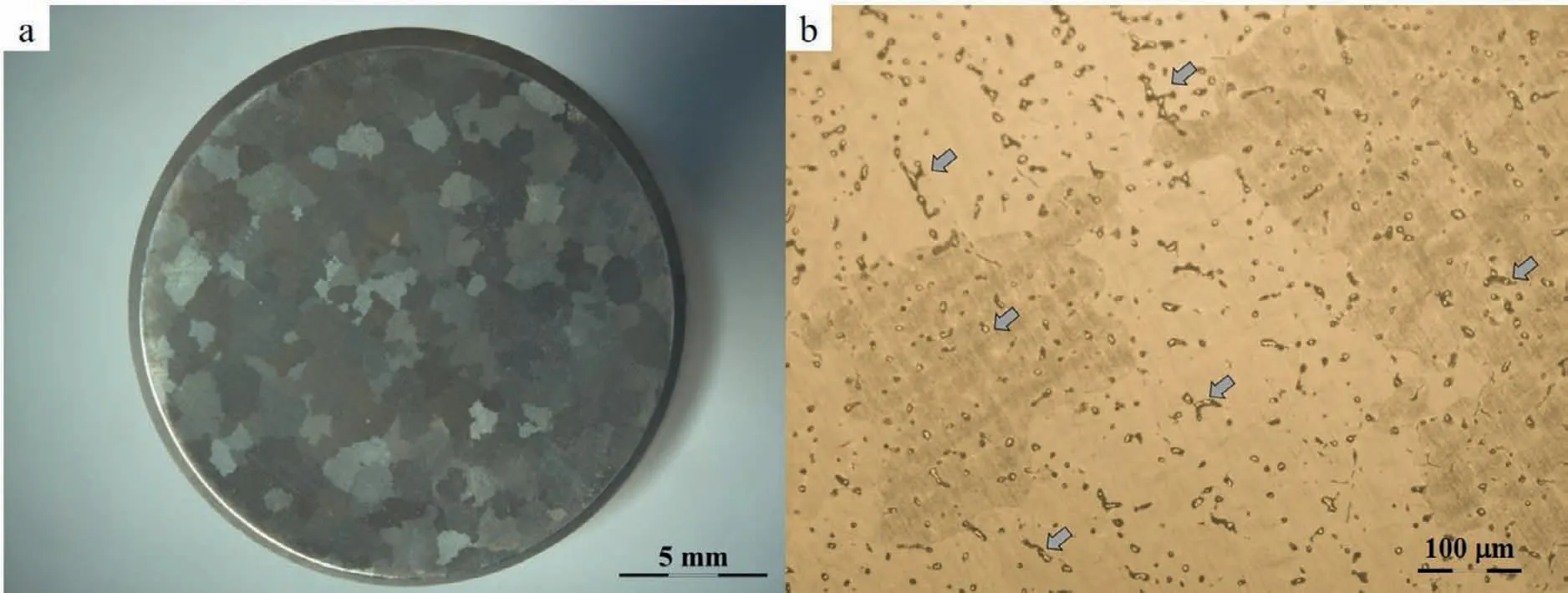
Fig.2.OM images of original (un-deformed) cast AZ91 Mg alloy sample: (a) cross section;(b) longitudinal section.
3.Results and discussions
3.1. Monotonic tensile and compressive plasticity
To clarify the basic mechanical properties of cast AZ91 Mg alloy and determine the suitable loading levels of cyclic tests in the next sections,monotonic tensile and compressive tests and corresponding microscopic observations are conducted at room temperature and a strain rate of 0.025%/s.The experimental results are demonstrated in Fig.3.From the monotonic tensile and compressive stress-strain (in absolute value)curves illustrated in Fig.3a,it is found that the cast AZ91 alloy expresses a tension-compression symmetry at room temperature,that is,the tensile yielding stress is consistent with the compressive yielding stress (80 MPa) and the tensile and compressive stress-strain curves are almost overlapped.From Fig.3b,it is observed that after monotonic tensile deformation to a strain of about 6.0%,some twins appear in the cast Mg alloy (shown by arrows in the OM image).Similarly,the EBSD results in the longitudinal section of the samples shown in Figs.3c and 3d further prove the occurrence of deformation twinning in both the monotonic tensile and compressive plastic deformations.Many extension twins can be observed in both the samples after the monotonic tensile and compressive deformations,which are marked by the blue lines in Fig.3c and the black lines in Fig.3d,and their volume fractions in the observation areas are 28.5% and 15.2%,respectively;besides,a few contraction twins are generated in the monotonic tensile deformation (the red line regions in Fig.3c with a volume fraction of 2.47%).It’s worth noting that the direction assigned by the black double arrow in the figures is the loading direction (LD) of the samples.Since its critical resolved shear stress (CRSS) is low,the extension twinning is easily activated by the tension along thec-axis or the compression perpendicular to thec-axis of Mg alloy grains.For the extruded Mg alloy,Kang et al.[23]pointed out that the basal plane texture makes thec-axis of most grains perpendicular to the extrusion direction;thus,in the compression parallel to the extrusion direction,the extension twinning can be easily activated,while in the tension along the extrusion direction,the non-basal slip system with a higher CRSS is first activated to coordinate the plastic deformation,leading to a lower compressive yielding stress than the tensile one.However,the crystallographic orientations of grains in the cast Mg alloys are almost randomly distributed without any strong texture [8].Thus,besides the dislocation slipping,the extension twins are formed in the grains with theirc-axes parallel to the tensile loading direction and those with theirc-axes perpendicular to the compressive loading direction,respectively.In a word,because its plastic deformations in both the tensile and compressive loadings are controlled by both the dislocation slipping and deformation twinning,the cast AZ91 Mg alloy exhibits almost perfect tension-compression symmetry in the monotonic plastic deformation as depicted in Fig.3a.In addition,the randomness of grain orientation leads to abundant twins in the upper-left grain which is defined as being in a soft orientation of extension twinning,and fewer twins in the lower-right grain which is defined as being in a hard orientation of extension twinning,as illustrated in Fig.3c and d.
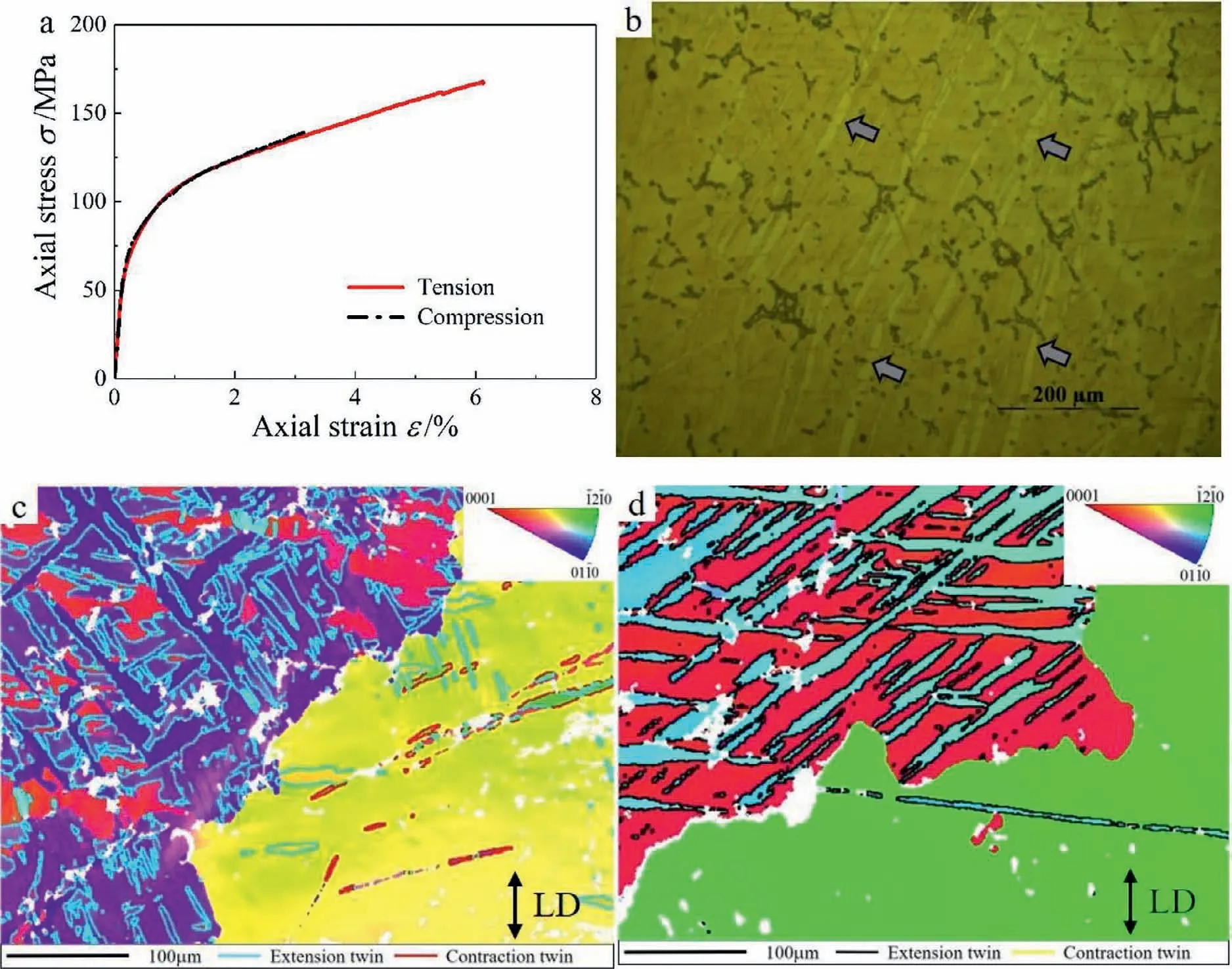
Fig.3.Monotonic tensile and compressive deformation results of cast AZ91 Mg alloy: (a) macroscopic stress-strain curves;(b) OM image of the sample after monotonic tension;(c) EBSD image of the sample after monotonic tension;(d) EBSD image of the sample after monotonic compression.
3.2. Strain-controlled cyclic plasticity
To explore the cyclic soft/hardening feature of cast AZ91 Mg alloy,some symmetrical cyclic straining tests are carried out,and the stress-strain curves and the variations of peak/valley stresses are demonstrated in Figs.4a to d firstly.It can be found from Figs.4a and c that the hysteresis loops of cast Mg alloy always present a convex and symmetrical shape within the applied range of strain amplitudes,which is similar to that of SS304 stainless steel (a FCC material) [35,36]shown in Fig.4e but obviously different from the S-shaped hysteresis loops of extruded AZ31 Mg alloy [23]shown in Fig.4f.This is because the plasticity of cast AZ91 Mg alloy exhibits the tension-compression symmetry shown in Fig.3a,which differs from the tension-compression asymmetry of extruded AZ31 Mg alloy caused by its strong basal plane texture.As shown in Figs.4a,c,d and e,both the cast AZ91 Mg alloy and SS304 stainless steel present obvious cyclic hardening feature,that is,the responding stress amplitude increases with the increase of cyclic number;however,as illustrated in Figs.4a,c and e,although both the two materials exhibit convex and symmetrical hysteresis loops and apparent cyclic hardening feature,the hysteretic loop shape and cyclic hardening behavior of cast Mg alloy apparently differ from that of SS304 stainless steel due to different microscopic mechanisms of cyclic plasticity.As shown in Figs.4a and c,in the hysteresis loops of cast AZ91 Mg alloy,the upward semiloops in the first several cycles will intersect or almost overlap with the stress-strain curve of initial monotonic tensile stage;also,as illustrated in Fig.4d,the cyclic hardening of the cast Mg alloy is weaker in the first several cycles than that in the subsequent cycles,and the extent of cyclic hardening firstly increases with increasing the cyclic number but decreases cyclically after certain cycles.Such phenomena differ from that observed in SS304 stainless steel,where no intersection or overlapping occurs and the extent of cyclic hardening continually decreases with increasing the cyclic number as shown in Fig.4e.Like in [30],obvious inelastic recovery presents in the unloading stages for the cast AZ91 Mg alloy as illustrated in Fig.4b,which is denoted as the pseudo-elastic behavior.
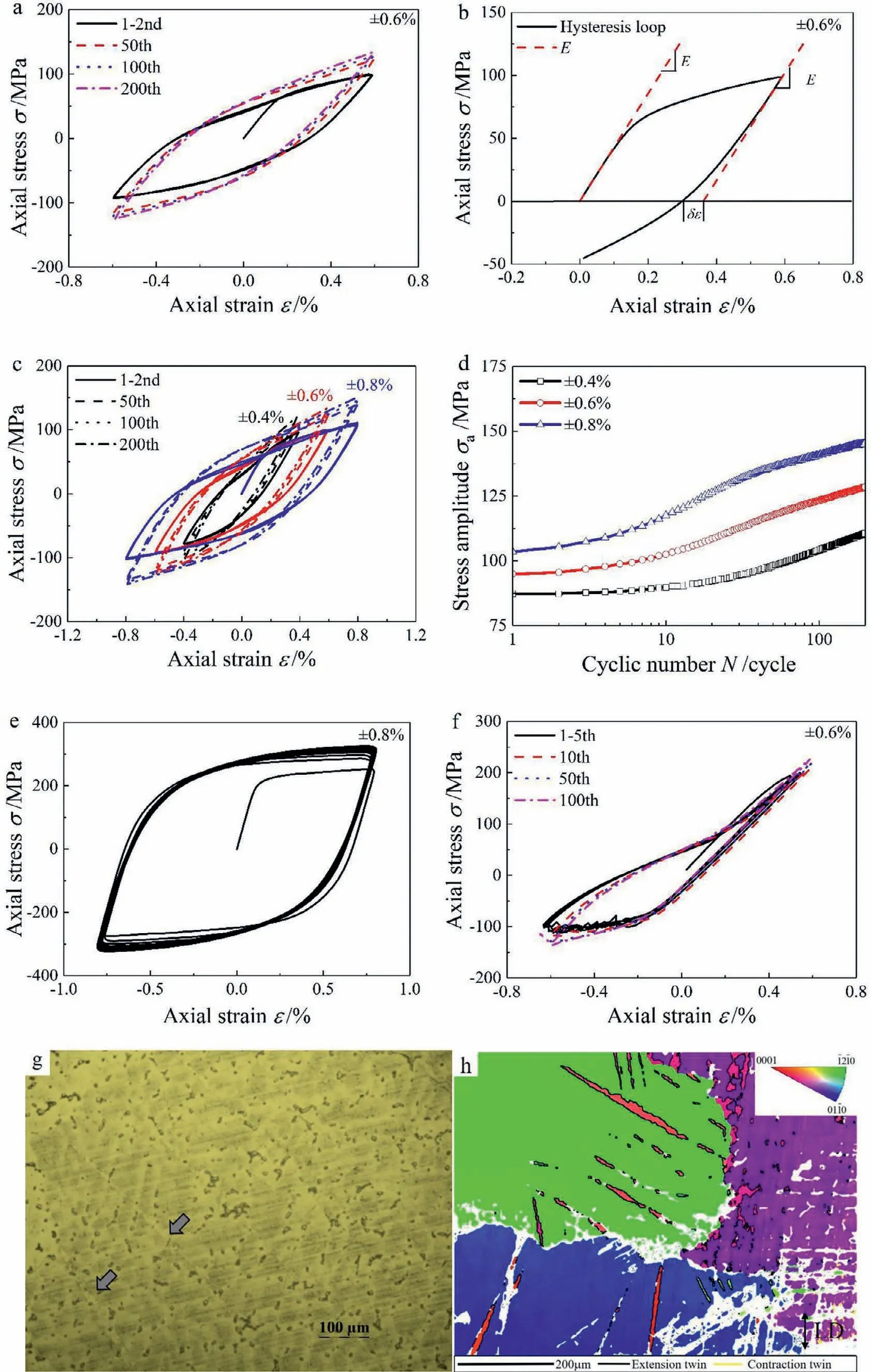
Fig.4.Symmetric straining cyclic results of cast AZ91 Mg alloy: (a) hysteresis loops with a strain amplitude of 0.6%,(b) pseudo-elastic behavior,(c)hysteresis loops with different strain amplitudes,(d) evolution curves of corresponding stress amplitude;(e) hysteresis loops of SS304 steel with a strain amplitude of 0.8% [36];(f) hysteresis loops of extruded AZ31 Mg alloy with a strain amplitude of 0.6% [23];(g) OM image of cast AZ91 alloy with a strain amplitude of 0.8% and after one cycle;(h) EBSD results of cast AZ91 alloy with a strain amplitude of 0.8% and after 200 cycles.
The above-mentioned distinctions of the cyclic plasticity between the two materials are attributed to the involved different plastic deformation mechanisms: (1) For SS304 stainless steel,its plastic deformation is controlled only by dislocation slipping due to its FCC crystalline structure when the deformation is not so large.Dislocation density increases rapidly and dislocation configuration changes significantly in the process of cyclic plastic deformation;thus,significant cyclic hardening takes place in the first several cycles and the resultant upward semi-loops are obviously higher than the stress-strain curve of initial monotonic tensile stage,without any intersection or overlapping;also,there is no pseudoelastic behavior in the unloading parts.(2) For the cast AZ91 Mg alloy,the extent of dislocation slipping is much less than that of SS304 stainless steel in the first several cycles due to its fewer activated slip systems;at the same time,the twins formed in the loading stages can be detwinned in the subsequent unloading stages.Thus,the extent of cyclic hardening becomes very weak in the first several cycles and the intersection or overlapping takes place,as shown in Figs.4a,c and d.On the other hand,the detwinning occurred in the unloading stages results in the pseudo-elastic behavior as discussed in[30]and the pseudo-elastic strain (δε) is recovered during the unloading,as illustrated in Fig.4b.
Concerning the unique cyclic hardening behavior of cast AZ91 alloy exhibited in Fig.4b,that is,the extent of cyclic hardening is very weak in the first several cycles with a relatively small strain amplitude (e.g.,0.4%),and then gradually increases with the increase of cyclic number,but finally decreases cyclically after certain cycles;however,the cyclic hardening becomes more remarkable in the cyclic straining tests with higher strain amplitudes.Such a three-staged evolution of cyclic hardening in the cast Mg alloy can be explained as follows with the help of necessary microscopic observations: due to its fewer slip systems and higher CRSS of dislocation slipping,the plastic deformation of cast Mg alloy is primarily controlled by the deformation twinning in the first beginning of cyclic plastic deformation;as illustrated in Figs.4g and h,with a strain amplitude of 0.8%,the residual twins (shown by arrows in Fig.4g,similar to that in Fig.3b)are hardly observed in the cast AZ91 alloy after only one cycle due to the detwinning,so the cyclic hardening is weak in the first beginning stage of cyclic plasticity;however,after 200 cycles,since the residual twins can gradually accumulate,more twins (represented by the black line regions in Fig.4h)are formed,leading to the significant increase of cyclic hardening with the help of increased dislocation density [37];after certain cycles,when the amount of residual twins and the dislocation density increase to certain critical values,further increase of them will become relatively difficult,and then the extent of cyclic hardening gradually decreases with the further increase of cyclic number,as shown in Fig.4d.
3.3. Stress-controlled cyclic plasticity
In Section 3.2,a unique cyclic hardening behavior is revealed from the symmetrical cyclic straining tests of cast AZ91 Mg alloy.How about the ratchetting of cast AZ91 Mg alloy in the cyclic stressing cases? So,in this section,a series of uniaxial cyclic stressing tests are conducted at room temperature to discuss the ratchetting of cast AZ91 Mg alloy and its evolution characteristics through comparing the obtained experimental results with that of extruded AZ31 Mg alloy and SS304 stainless steel,respectively.
3.3.1.Symmetrical cyclic stressing tests
Figs.5a to d give the stress-strain curves,the variations of peak strain (PE),valley strain (VE) and ratchetting strain(defined as the average of PE and VE) gained in the cyclic stressing tests of cast AZ91 Mg alloy with a mean stress of 0 MPa and various stress amplitudes of 90,100 and 110 MPa,respectively.For comparison,Figs.5e and f provide the experimental results of extruded AZ31 Mg alloy obtained by Kang et al.[23]in the tests with a mean stress of 0 MPa and different stress amplitudes of 100 and 120 MPa,respectively.As can be found from Figs.5a to f,the obtained hysteresis loops and responding strain evolutions are dramatically different in the cyclic stressing tests of cast AZ91 and extruded AZ31 Mg alloys: (1) Firstly,similar to the hysteresis loops gained in the cyclic straining tests,the hysteresis loops of cast AZ91 alloy in the symmetrical cyclic stressing tests are also convex and symmetrical,and the intersection or overlapping phenomena of the upward semi-loops in the first several cycles and the initial monotonic tensile stress-strain curve also take place,as presented in Figs.5a to c.This is different from the asymmetric hysteresis loops of extruded AZ31 alloy demonstrated in Fig.5e.Similar to the discussion in Section 3.2,different shapes of the loops of the cast and extruded Mg alloys result from their different microstructures(with and without strong basal plane textures) and plastic deformation mechanisms involved.With the increase of cyclic number,the loops of cast AZ91 alloy become narrower and narrower because of the gradually enhanced cyclic hardening discussed in Section 3.2,as illustrated in Figs.5a to c.(2) Although the responding PE point of cast Mg alloy moves to the backward direction and the VE point moves to the forward direction of transverse axis in Figs.5a to c during the cyclic stressing tests as that of extruded Mg alloy demonstrated in Fig.5e,the moving rates of peak and valley points are almost the same for the cast Mg alloy due to its tension-compression symmetry and the ratchetting strain here is close to zero as illustrated in Fig.5d.Whereas,for the extruded AZ31 alloy,the moving rates of peak and valley points are different due to its tension-compression asymmetry involving different plastic deformation mechanisms,which leads to a significant ratchetting strain in the compressive direction,especially in the first several cycles (depicted in Fig.5f).

Fig.5.Results of cast and extruded Mg alloys in the stress-controlled symmetrical cyclic tests: hysteresis loops of cast AZ91 Mg alloy with varied stress amplitudes (Sa) of (a) 90 MPa,(b) 100 MPa,and (c) 110 MPa;(d) evolution curves of PE,VE and ratchetting strain for the cast Mg alloy;(e) hysteresis loops of extruded AZ31 Mg alloy with a Sa of 110 MPa [23];(f) evolution curves of PE,VE and ratchetting strain for the extruded Mg alloy [23].
3.3.2.Ratchetting with low mean stress
Figs.6a to d exhibit the stress-strain curves and the PE and VE variations of cast AZ91 Mg alloy gained in the cyclic stressing tests with a stress amplitude of 90 MPa and relatively low positive mean stresses of 20,30 and 40 MPa,respectively.As demonstrated in Figs.6a to c,in the cyclic stressing tests with relatively low mean stresses: (1) The responding hysteresis loops of cast AZ91 Mg alloy are convex and symmetrical,which are similar to that of SS304 stainless steel [35]presented in Fig.6e,but different from the Sshaped asymmetrical loops of extruded AZ31 alloy depicted in Fig.6f.The reason is the same as that explained in Section 3.2 for the cyclic straining cases.(2) Although both the cast AZ91 Mg alloy and SS304 stainless steel exhibit the tension-compression symmetry,the ratchetting of the cast Mg alloy differs apparently from that of SS304 stainless steel as illustrated in Fig.6.For the cast AZ91 Mg alloy,the evolutions of PE and VE and then the ratchetting depend greatly on the applied mean stresses.When the mean stress is 20 MPa,contrary moving directions are observed for the peak and valley points at different moving rates as exhibited in Fig.6a;when the mean stress increases to 30 MPa,the PE and VE points move to the same direction and more apparent ratchetting occurs but the moving rate of VE points is faster than that of PE points,as depicted in Figs.6b and d;when the mean stress further increases to 40 MPa,the difference in the moving rates of PE and VE points becomes smaller and the ratchetting becomes more remarkable,as shown in Figs.6c and d.However,for SS304 stainless steel,the peak and valley points both move to the forward direction of transverse axis at almost the same moving rates,and significant ratchetting occurs in the tensile direction of the sample.Such a difference is caused by different plastic deformation mechanisms involved.That is,the cyclic plasticity of cast Mg alloy is dominated by both the dislocation slipping and twinning,but the deformation twinning exhibits strong polarity;while,for SS304 stainless steel,its cyclic plasticity is primarily controlled by the dislocation slipping without polarity.(3) The evolutions of PE and VE and then the ratchetting of cast Mg alloy at low mean stress are also different from that of extruded Mg alloy as presented in Figs.6a,b,c and f,which is attributed to the strong basal plane texture in the extruded Mg alloy and no such a texture in the cast Mg alloy.
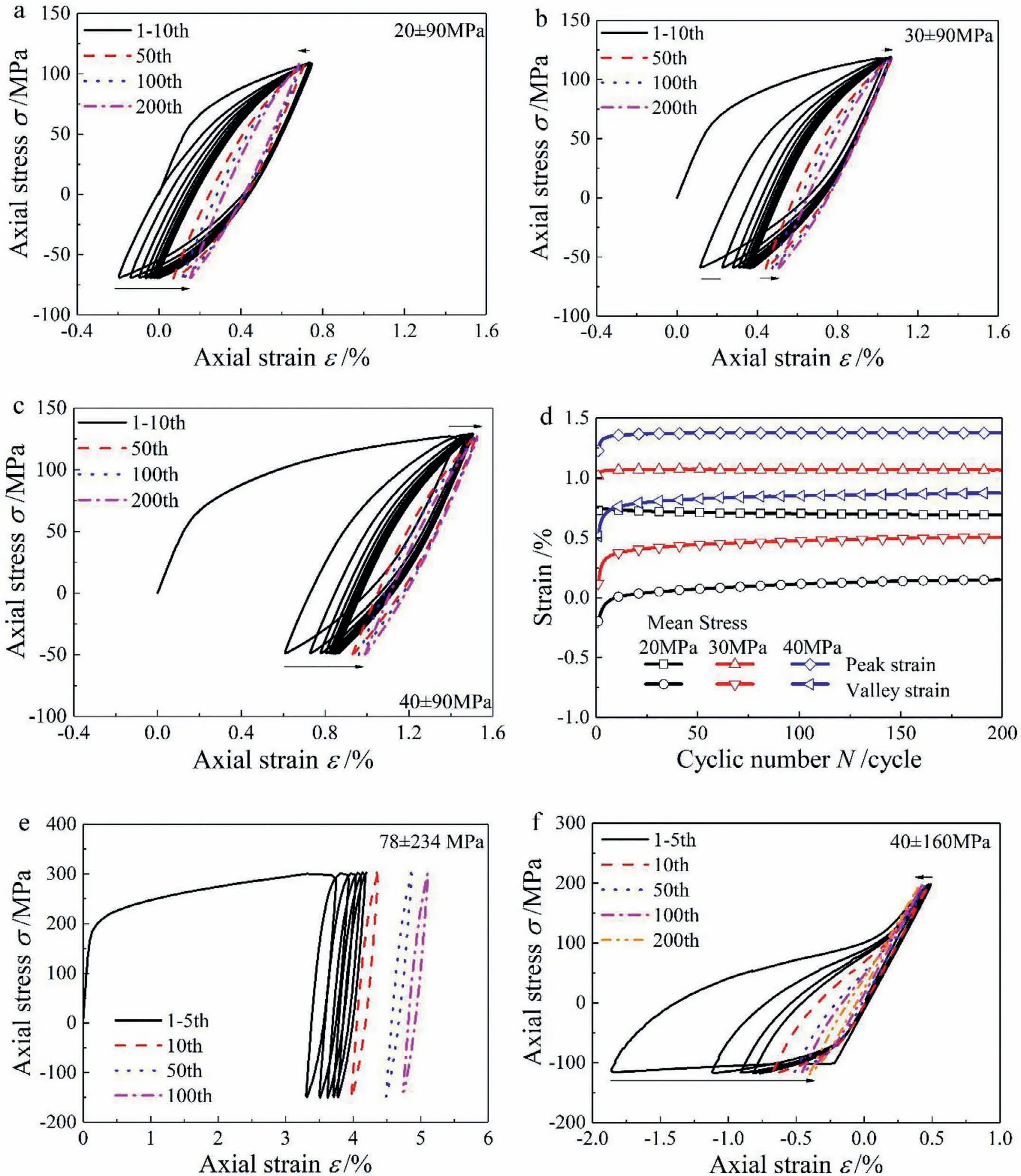
Fig.6.Results of different materials in the cyclic stressing tests: hysteresis loops of cast AZ91 Mg alloy with a Sa of 90 MPa and different positive mean stresses (Sm) of (a) 20 MPa,(b) 30 MPa,(c) 40 MPa,and (d) corresponding variation curves of PE and VE;(e) hysteresis loops of SS304 stainless steel with 78±234 MPa [35];(f) hysteresis loops of extruded AZ31 Mg alloy with 40±160 MPa [23].
Figs.7a to c provide the experimental results of cast AZ91 alloy obtained in the cyclic stressing tests with an identical stress amplitude (90 MPa) and negative mean stresses of-20 and-40 MPa,respectively.When a low mean stress of-20 MPa is applied,as depicted in Fig.7a,the hysteresis loop shapes are similar to that in Fig.6a due to the tension-compression symmetry of the alloy and contrary moving directions of peak and valley points are also observed,but the peak point moves to the forward direction of transverse axis at a much higher moving rate and the valley point moves to the backward direction of transverse axis here,different from that demonstrated in Fig.6a for the case with a positive mean stress of 20 MPa;when the negative mean stress increases to-40 MPa,although both the PE and VE points move to the backward direction of transverse axis,the moving rate of peak point becomes much higher than that of valley point,which differs from that shown in Figs.6b and c.Comparison between Figs.7a and d demonstrates that although the hysteresis loops of cast and extruded Mg alloys are both convex and symmetrical,the evolution characteristics of the PE and VE of cast Mg alloy are apparently different from that of extruded AZ31 alloy under a loading condition of-20±120 MPa,on account of different plastic deformation mechanisms involved.That is,as shown in Fig.7a,both the dislocation slipping and deformation twinning can be activated in the cyclic stressing test of cast Mg alloy under a loading condition of-20±90 MPa,but only the deformation twinning can be activated in the extruded AZ31 alloy under a loading condition of-20±120 MPa depicted in Fig.7d.
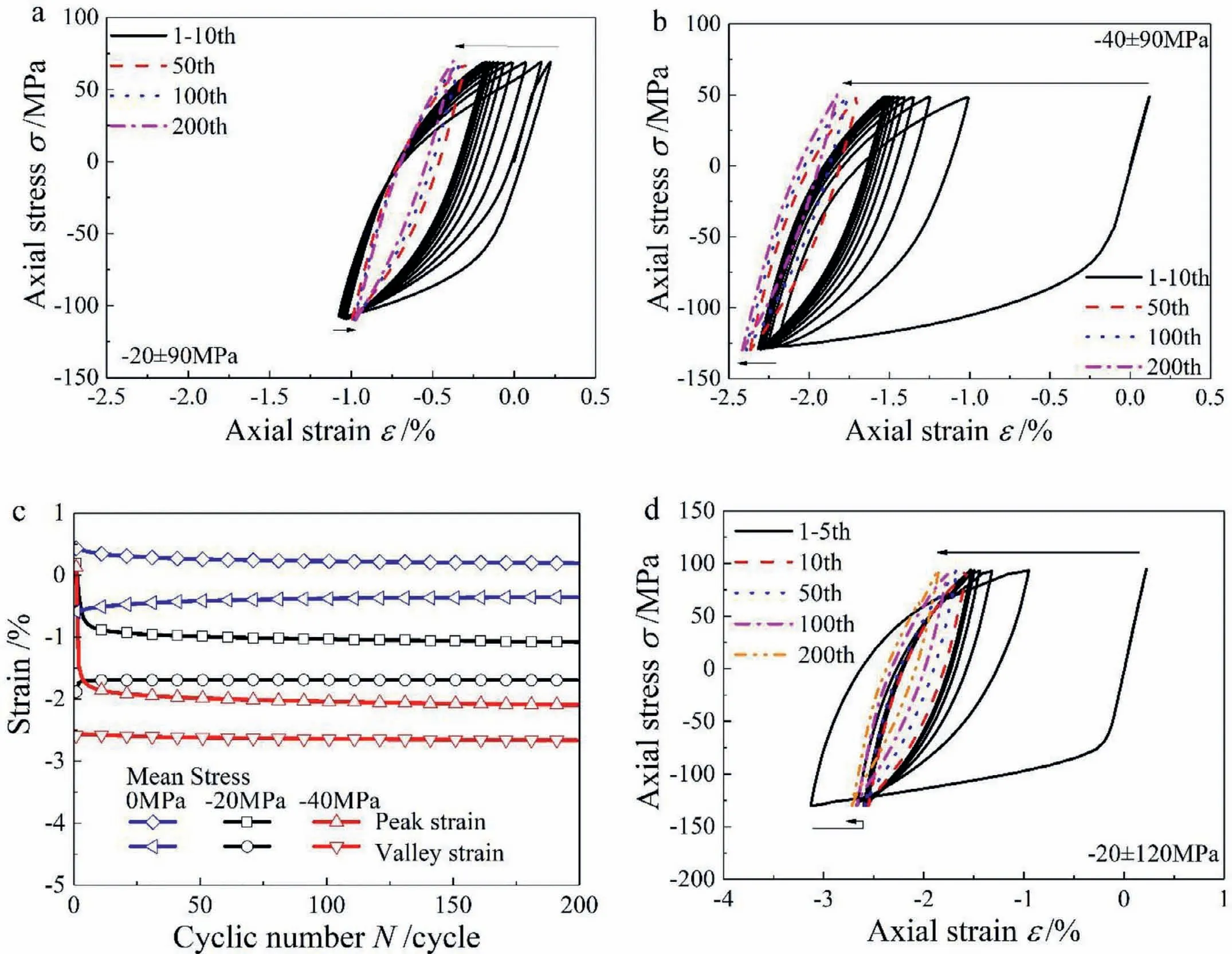
Fig.7.Results of Mg alloys in the cyclic stressing tests: hysteresis loops of cast AZ91 alloy with a Sa of 90 MPa and two negative Sm of (a)-20 MPa,(b)-40 MPa,and (c) variation curves of PE and VE;(d) hysteresis loops of extruded AZ31 alloy with-20±120 MPa [23].
To investigate the effect of the change in the stress amplitude on the ratchetting of cast AZ91 Mg alloy with a low mean stress,some cyclic stressing tests are performed with two low mean stresses of 20 and-20 MPa and varied stress amplitudes of 80,90,100 and 110 MPa.Fig.8 gives the obtained typical hysteresis loops and the variations of PE and VE,as well as an EBSD image for the longitudinal section of the sample after 200 cycles (with 20±110 MPa).As illustrated in Figs.8a to f,with increasing the stress amplitude,although the evolution directions of PE and VE keep unchanged,the moving rates of valley points in the cases with a positive mean stress and peak points in the cases with a negative mean stress becomes quicker than that of their counterparts,and more significant ratchetting occurs.After 200 cycles,it is found from the EBSD observation illustrated in Fig.8g that a large number of extension twins (black line regions) are formed in the cast AZ91 alloy with a volume fraction of 42.6%,and a small number of contraction twins(red line regions) are also observed,which reflects the accumulation of residual twins during the cyclic stressing tests and results in a remarkable cyclic hardening in the material (represented by the cyclically narrowed hysteresis loops shown in Figs.8a to c and e).
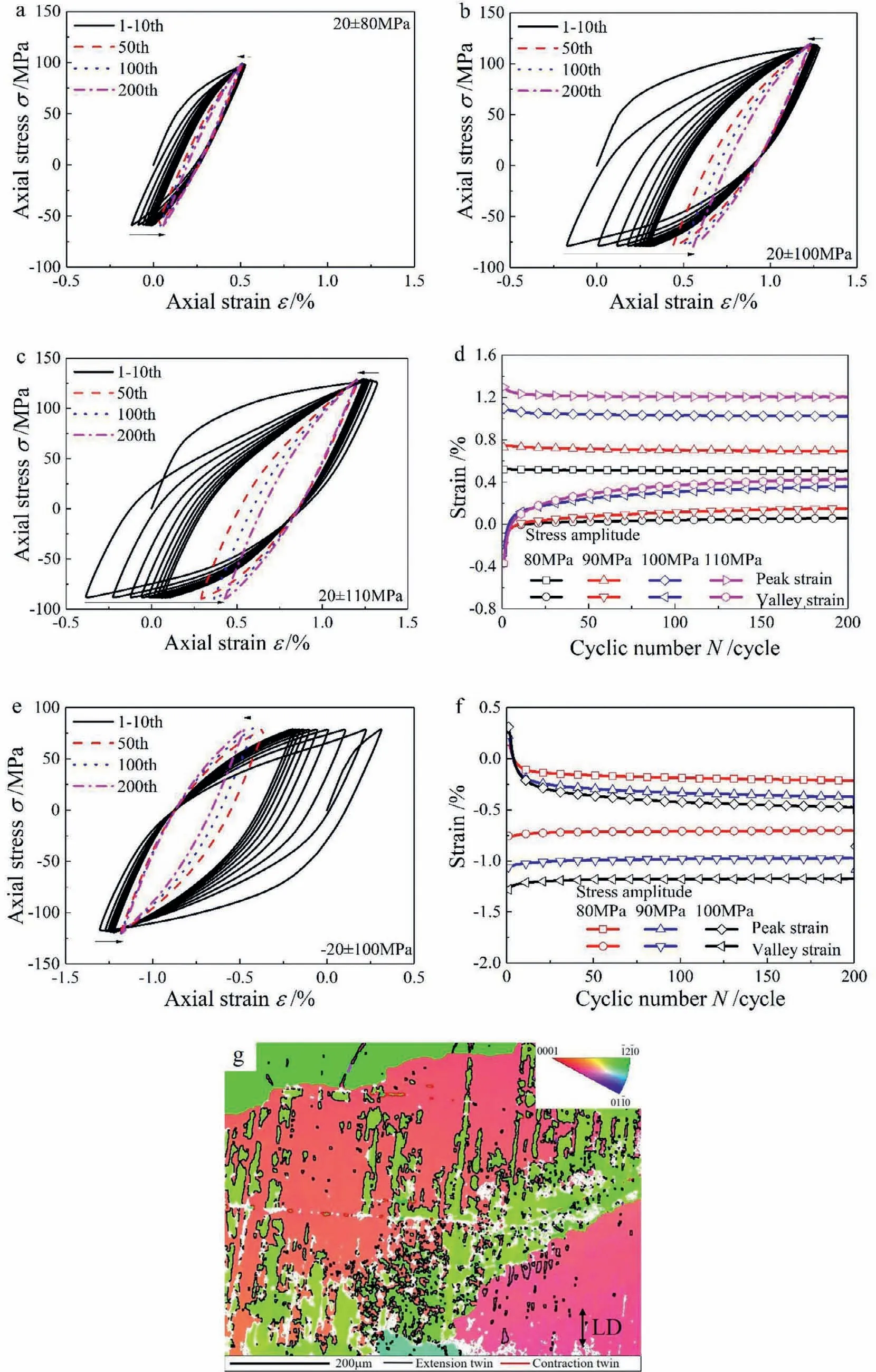
Fig.8.Results of cast AZ91 Mg alloy in the cyclic stressing tests: stress-strain curves with a constant Sm of 20 MPa and three Sa of (a) 90 MPa,(b) 100 MPa,(c) 110 MPa,and (d) variation curves of PE and VE;(e) hysteresis loops with a constant Sm of-20 MPa and Sa of 100 MPa,and (f) variation curves of PE and VE with various Sa;(g) EBSD image after 200 cycles with 20±110 MPa.
3.3.3.Ratchetting with high mean stress
Figs.9a to e display the stress-strain curves and the PE and VE evolution curves of cast AZ91 Mg alloy with a constant stress amplitude of 60 MPa and various higher mean stresses of 50,60,70 and 80 MPa,respectively.As illustrated in Figs.9a to d,in the prescribed loading cases with some high mean stresses: (1) the hysteresis loops of cast AZ91 alloy keep being convex,but are wider than that of SS304 stainless steel and extruded AZ31 Mg alloy obtained in the cyclic tension-unloading tests and presented in Figs.9f and g,respectively.The reason for such a difference is that,in the cyclic tension-tension tests,the plastic deformations of the SS304 stainless steel and extruded AZ31 alloy are both dominated only by dislocation slipping;while,the plastic deformation of cast AZ91 alloy is still dominated by dislocation slipping and twinning/detwinning,simultaneously.The pseudo-elasticity occurred during the unloading due to the detwinning results in the wider loops of cast AZ91 alloy.(2) Different from the same moving directions and rates of responding PE and VE points for SS304 stainless steel and extruded AZ31 Mg alloy depicted in Figs.9f and g,although the PE and VE points of cast AZ91 Mg alloy move to the forward direction during the cyclic loading,too,the moving rate of PE in the initial cycles is significantly slower than that of VE (depicted in Figs.9a to d).This is because in these loading cases,besides the strong polarity of deformation twinning,the recoverable pseudo-elastic strain of cast AZ91 alloy caused by the detwinning at the unloading stage can be restrained by the accumulation of residual twins during the cyclic deformation,which also gives rise to a faster moving rate of the valley points along the forward direction(i.e.,tensile direction) in the initial cycles.(3) At high mean stresses,the increase of mean stress does not significantly promote the ratchetting of cast AZ91 alloy,different from the remarkable promotion of increasing the mean stress to the ratchetting of cast AZ91 alloy at low mean stresses(discussed in Section 3.3.2).Moreover,the ratchetting of cast AZ91 Mg alloy at high mean stress is much weaker than that of SS304 steel and extruded AZ31 Mg alloy depicted in Fig.9f and g.For SS304 stainless steel,in the cyclic tension-unloading test,the obvious ratchetting actually results from the remarkable viscosity even at room temperature [35,38],due to the lack of reverse plasticity;whereas,for the extruded AZ31 alloy,owing to the strong texture,only the dislocation slipping is involved in the cyclic tension-unloading,no deformation twinning occurs,which results in a different ratchetting from the cast AZ91 alloy.
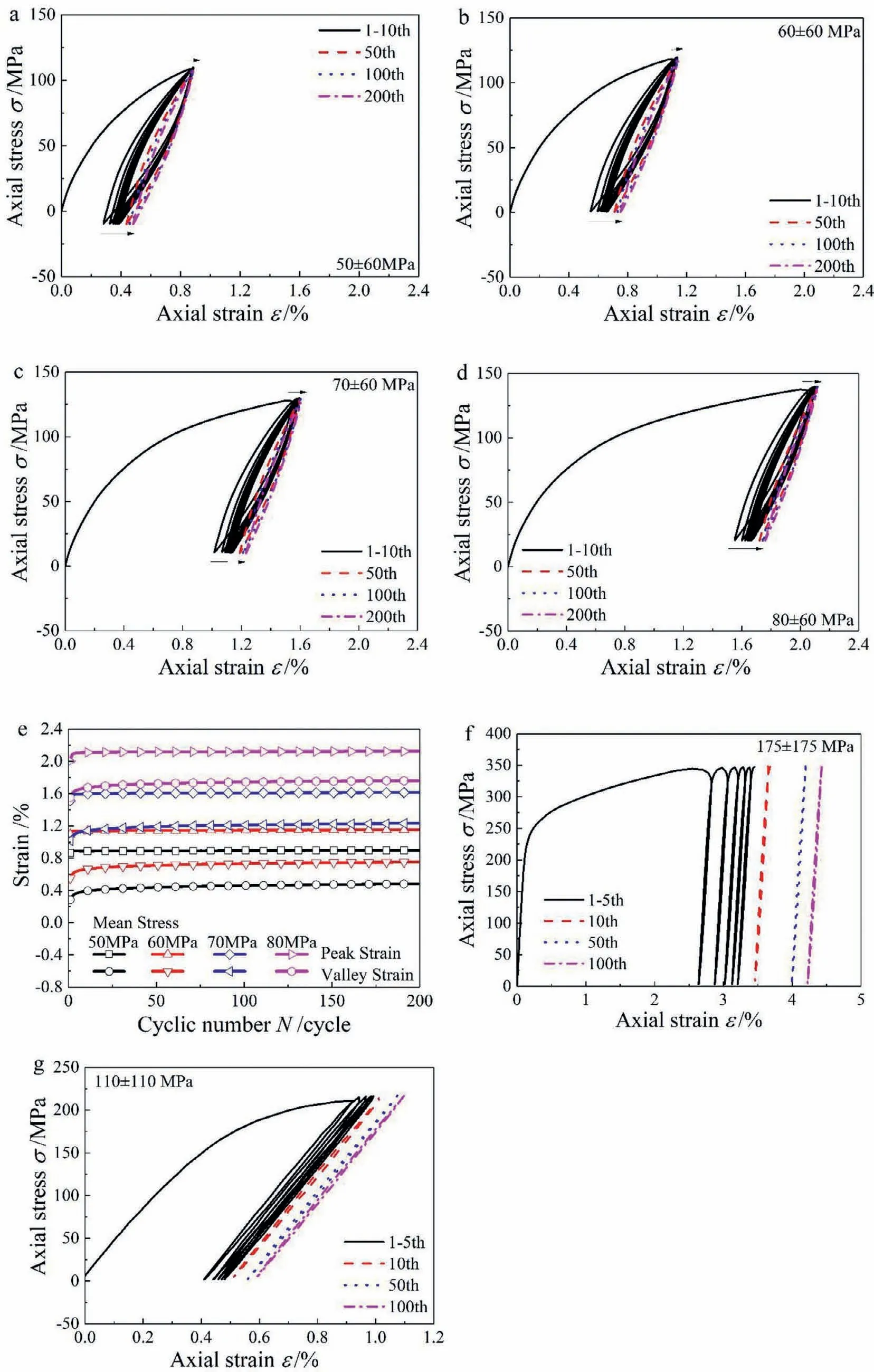
Fig.9.Results of different materials in the cyclic stressing tests: hysteresis loops of cast AZ91 Mg alloy with a Sa of 60 MPa and different positive Sm of(a) 50 MPa,(b) 60 MPa,(c) 70 MPa,(d) 80 MPa,and (e) corresponding variation curves of PE and VE;(f) hysteresis loops of SS304 stainless steel under 175±175 MPa [38];(g) hysteresis loops of extruded AZ31 Mg alloy under 110±110 MPa [24].
On the other hand,Figs.10a to c show the experimental results of cast AZ91 alloy obtained in the cyclic stressing tests with a stress amplitude (60 MPa) and negative mean stresses of-50,-60 and-70 MPa,respectively.As illustrated in Figs.10a and b,with the negative and high mean stresses(higher than-20 and-40 MPa used in Section 3.3.2),the hysteresis loops are also convex and obvious pseudo-elasticity also takes place during the unloading,which is similar to that illustrated in Figs.9b and c with positive mean stresses and that of extruded AZ31 alloy depicted in Fig.10d during the cyclic compression-compression loading.The reason for the above-mentioned similarity is that: under these loading conditions,the cyclic plastic deformation of extruded AZ31 alloy is primarily controlled by the twinning/detwinning mechanism[23],which is also easy to be activated in the soft oriented grains of cast AZ91 Mg alloy;thus,both the two Mg alloys present similar hysteresis loop shape under the cyclic compression-compression loading conditions.Meanwhile,the PE and VE points of both the extruded AZ31 and cast AZ91 alloys move to the backward direction of transverse axis,and the moving rate of PE point is faster than that of VE point because of the pseudo-elasticity (as demonstrated in Figs.10c and d).The increase of negative mean stress (in absolute value) leads to more remarkable ratchetting,as demonstrated in Figs.10a to c.

Fig.10.Results of Mg alloys in the cyclic stressing tests: hysteresis loops of cast AZ91 Mg alloy with constant Sa of 60 MPa and different negative Sm of(a)-60 MPa,(b)-70 MPa,(c) variation curves of PE and VE;(d) hysteresis loops of extruded AZ31 Mg alloy under-60±60 MPa [23].
From Fig.9,it can be found that the uniaxial ratchetting of cast AZ91 Mg alloy is not so significant as that of SS304 stainless steel and extruded AZ31 Mg alloy under the cyclic tension-tension loading condition with a low stress amplitude.Thus,to elucidate the influence of stress amplitude on the ratchetting of cast AZ91 Mg alloy at high mean stress(50 MPa),higher stress amplitudes of 70,80 and 90 MPa(higher than 60 MPa in Fig.9) are prescribed during the corresponding cyclic tension-compression tests.Figs.11a to d exhibit the obtained stress-strain curves and the variations of PE and VE with a mean stress of 50 MPa and various stress amplitudes,respectively,and Fig.11e provides an EBSD image for the longitudinal section of the sample after the ratchetting test with the stress level of 50±80 MPa.As demonstrated in Figs.11a to c,the convex loops and evolution trends of PE and VE remain the same as that shown in Figs.9a to d,but the evolution rates of PE and VE become more and more quicker (especially for the PE) and the ratchetting becomes more obvious with increasing the stress amplitude.However,the ratchetting of cast AZ91 Mg alloy with high mean stress and stress amplitude is still different from that of extruded AZ31 alloy as shown in Fig.11f and controlled mainly by the dislocation slipping.From the microscopic view,as shown in Fig.11e,considering the apparent accumulation of twins during the cyclic plastic deformation,abundant twins are observed in the cast Mg alloy through the EBSD observation(red line regions,the volume fraction of extension twins up to 57.8%),which causes the significant cyclic hardening of the alloy,and makes the hysteresis loop narrower and narrower.After certain cycles,the ratchetting strain rate (i.e.,the increment of ratchetting strain after each cycle) becomes to be almost zero,and a shakedown of ratchetting occurs,as depicted in Fig.11d.
In addition,Fig.12 provides the experimental results of cast AZ91 alloy in the cyclic stressing tests with a mean stress of-70 MPa and different stress amplitudes (that is,50,60 and 70 MPa).It can be found that when the negative mean stress is used,similar to that with the positive mean stress (50 MPa) and depicted in Figs.11a to d,the moving rates of PE and VE points in the initial stage of cyclic tests increase with increasing the stress amplitude,and then the ratchetting in the compressive direction becomes more remarkable.
3.3.4.Effect of stress rate on ratchetting
Although there have been some experimental studies concerning the effect of stress rate on the ratchetting of wrought Mg alloys [24,28],the effect of stress rate on the ratchetting of cast Mg alloys has not been touched yet.Based on the experimental investigations on the uniaxial ratchetting of cast AZ91 alloy in the previous subsections with different stress levels,two stress levels of 70±70 MPa and 20±110 MPa are selected in this subsection to conduct the cyclic tests at three stress rates of 5 MPa/s,20 MPa/s and 100 MPa/s,respectively.Fig.13 depicts the stress-strain curves of cast AZ91 alloy in the first ten cycles and the variations of PE and VE within 200 cycles at various stress rates.As demonstrated in Figs.13a and c,at different stress rates,the initial monotonic tensile stress-strain curves are nearly overlapped,but the responding peak strains corresponding to the applied peak stress are different at various stress rates and decrease obviously with increasing the stress rate.That is,the values of initial PE are 2.20% (5 MPa/s),2.11% (20 MPa/s) and 1.95% (100 MPa/s),respectively,under the loading condition of 70±70 MPa;and 1.68% (20 MPa/s) and 1.36% (100 MPa/s),respectively,under the loading condition of 20±110 MPa.As mentioned by Lin et al.[28],the stress rate has little effect on the formation of twins and the ratchetting of AZ31 Mg alloy;however,refs.[39–41]proposed that a high strain rate will promote the development of twinning/detwinning but limit the multiplication of dislocation slipping.Thus,the ratchetting of cast AZ91 alloy is obviously influenced by the stress rate as shown in Figs.13b and d,since it is dominated by both the twinning and dislocation slipping.Nevertheless,the comparison of the results in Figs.13b,d and e demonstrates that the change of stress rate has much weaker effect on the uniaxial ratchetting of cast AZ91 Mg alloy than it does on that of SS304 stainless steel on account of the obvious viscosity of SS304 stainless steel.
4.Conclusion
The following conclusions can be drawn out from the uniaxial monotonic and cyclic straining and stressing tests of cast AZ91 Mg alloy at room temperature:
(1) In monotonic tensile and compressive tests,the cast AZ91 Mg alloy presents a tension-compression symmetry,different from the wrought Mg alloy with a strong texture.The reason is that the plastic deformation of cast AZ91 Mg alloy is controlled by dislocation slipping and deformation twinning,simultaneously,in both the tensile and compressive loadings because no strong texture occurs in the alloy.
(2) In the cyclic straining tests,the hysteresis loop of cast AZ91 Mg alloy presents a convex and symmetrical shape because of its tension-compression symmetry and an obvious pseudo-elastic behavior occurs during the unloading due to the occurrence of detwinning.Different from that of BCC materials (e.g.,SS304 stainless steel),the upward semi-loops in the first several cycles intersect or overlap with the initial monotonic tensile curves on account of the contribution of twinning/detwinning.In addition,the accumulation of residual twins during the cyclic deformation results in the significant cyclic hardening of cast AZ91 Mg alloy.
(3) In the symmetrical cyclic stressing tests,there is no obvious ratchetting strain in the cast AZ91 Mg alloy,which is caused by the tension-compression symmetry.While,in the asymmetrical cyclic stressing tests,the ratchetting occurs in the cast AZ91 alloy but the moving directions and rates of PE and VE points are strongly dependent on the magnitudes of stress amplitude and mean stress: with low mean stress,the evolution directions of PE and VE change with the varied mean stress;owing to the rapid accumulation of twins and insufficient detwinning,the ratchetting is not remarkable in the cases with high mean stress and low stress amplitude;nevertheless,the evolution rates of PE and VE increase with increasing the stress amplitude.
(4) The ratchetting of cast AZ91 Mg alloy presents a certain stress rate-dependence,and the responding PE and VE(that is,the ratchetting strain) decrease slightly with the increase of stress rate.
The obtained experimental results provide a solid fundamental to the construction of corresponding cyclic plasticity constitutive model for the cast Mg alloys.
Declaration of Competing Interest
The authors declared that they have no conflicts of interest to this work.
Acknowledgments
Financial support from National Natural Science Foundation of China (11532010) is gratefully acknowledged.
杂志排行
Journal of Magnesium and Alloys的其它文章
- Corrosion behavior of composite coatings containing hydroxyapatite particles on Mg alloys by plasma electrolytic oxidation: A review
- Rational design,synthesis and prospect of biodegradable magnesium alloy vascular stents
- Antibacterial mechanism with consequent cytotoxicity of different reinforcements in biodegradable magnesium and zinc alloys: A review
- Preparation,interfacial regulation and strengthening of Mg/Al bimetal fabricated by compound casting: A review
- Pitting corrosion behavior and corrosion protection performance of cold sprayed double layered noble barrier coating on magnesium-based alloy in chloride containing solutions
- Designing strategy for corrosion-resistant Mg alloys based on film-free and film-covered models
